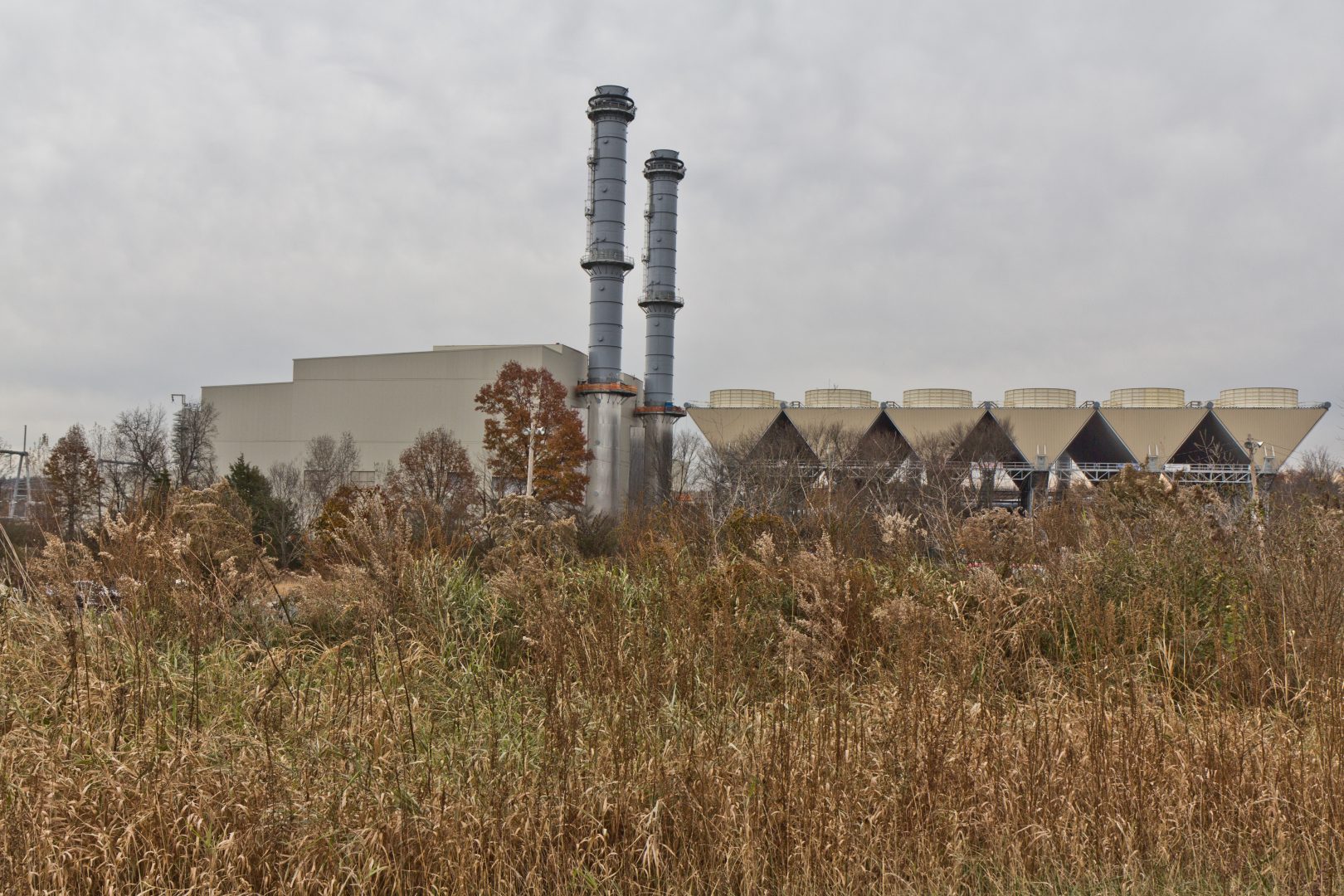
CPV's Valley Energy Center in Wawayanda, NY sits on 122 acres and would generate 650 megawatts of power. It will rely on Marcellus Shale gas from Pennsylvania.
Kimberly Paynter / WHYY


CPV's Valley Energy Center in Wawayanda, NY sits on 122 acres and would generate 650 megawatts of power. It will rely on Marcellus Shale gas from Pennsylvania.
Kimberly Paynter / WHYY

Kimberly Paynter / WHYY
CPV's Valley Energy Center in Wawayanda, NY sits on 122 acres and would generate 650 megawatts of power. It will rely on Marcellus Shale gas from Pennsylvania.
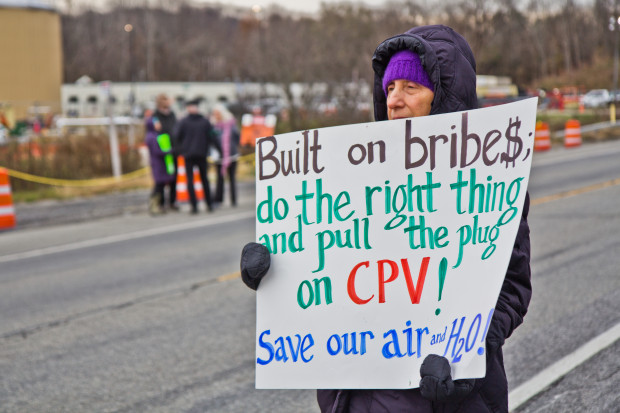
Kimberly Painter / WHYY
Roz Gitt from Warwick, New York, protests in front of the construction site for the new CPV natural gas plant in Wawayanda. The plant would run on Pennsylvania’s Marcellus Shale gas.
In 2014, Gov. Andrew Cuomo made a bold statement by banning hydraulic fracturing in the Empire State, declaring alongside his health commissioner that “no child should live near” a shale-gas well because of its potential harm.
The governor’s proclamation made him a hero among environmentalists and persona non grata in the oil and gas industry. Energy in Depth, an industry-funded website, criticized Cuomo for basing the moratorium on dubious science “to kowtow to Yoko Ono, Mark Ruffalo, and all of the environmental pressure groups in New York.”
In truth, though, the picture is murkier, and Cuomo’s ban is less than absolute. Moratorium notwithstanding, New York is still reaping the rewards of fracking, importing shale gas from neighboring Pennsylvania and preparing to process it in a mammoth power plant under construction 65 miles northwest of New York City.
“It goes to the heart of the apparent irony that New York State would say, ‘No shale gas coming out,’ but we’re allowing any amount of shale gas into the state,” said Anthony Ingraffea, an engineer at Cornell University whose work has tied fracking to various environmental ills, including climate change. By his calculations, drillers outside the state would have to tap 130 wells each year, on average, to supply the plant with enough gas to operate. That translates into thousands of fracked wells over the 40-year lifetime typical for such a facility.
“I’m using the polite word ‘irony,’” Ingraffea said. “I could also use the impolite word ‘hypocrisy.’”
A mass of panels and tanks, the 650-megawatt CPV Valley Energy Center is rising in this town of 7,000 people in the wooded hills of Orange County. Its 275-foot stacks tower above apple orchards and dairy farms.
The plant, a $900 million project of the Maryland energy company Competitive Power Ventures, stands at a nexus of new and expanding gas infrastructure here — much of it fed by fracking. Seven miles south, a compressor station that pumps gas to keep it moving squats amid houses. To the west, a pipeline stretches toward the Marcellus Shale fields in Pennsylvania. Construction on another one could begin soon pending a court order.
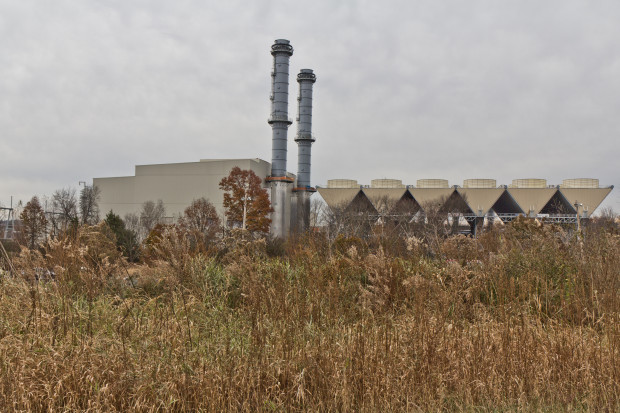
Kimberly Paynter / WHYY
CPV’s Valley Energy Center in Wawayanda, NY sits on 122 acres and would generate 650 megawatts of power. It will rely on Marcellus Shale gas from Pennsylvania.
The CPV plant, scheduled to go into service in early 2018, represents the leading edge of a broader trend in New York. It’s the first of two gas-fired power plants approved in the Hudson Valley. These plants, and 11 more that may come online across the state by 2020, collectively would add 5,708 megawatts of capacity to an electricity grid already fueled 57 percent by gas. New York has a surplus of gas-generated capacity. Statewide, the demand for electric power has grown, on average, only .23 percent per year since 2004.
The gas boom comes at a time when the Cuomo administration is undertaking a major clean-energy initiative. The governor unveiled the plan in 2015, calling it a roadmap for “a clean, resilient, and affordable energy system.” His administration has vowed to double the amount of electricity generated by solar, wind and other renewable sources — to 50 percent, from the current 24 percent — while reducing greenhouse-gas emissions 40 percent below 1990 levels by 2030 — an aggressive target. Last year, a Cuomo press release described climate change as “a very real threat that continues to grow by the day.”
New gas plants would work against the state’s clean-energy goals, said Eleanor Stein, a former administrative law judge at the New York Public Service Commission who managed the initiative from 2014 to 2015. That plan may not prohibit new gas plants, she said, but building them will lock in fossil-fuel use for decades, boosting greenhouse gases as officials strive to cut them.
“We are in a state of emergency,” said Stein, now a climate law professor at Albany Law School. “Every year we don’t act is lost forever.”
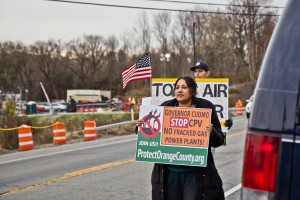
Kimberly Paynter / WHYY
Pramilla Malick protests at the construction site of CPV’s Valley Energy Center in Wawayanda, NY. Malick has been protesting weekly for the past three years.
Cuomo’s top energy advisers didn’t respond to multiple interview requests by the Center for Public Integrity and StateImpact Pennsylvania over the past month. A spokesman for the New York Public Service Commission declined to make senior officials available for an interview. Instead, he pointed to an agency order, issued in 2016, adopting a series of “deliberate and mandatory actions” to implement Cuomo’s energy plan. In the order, the commission recommends preserving New York’s carbon-free nuclear power plants as a bridge to clean energy, and recognizes that “significantly increased air emissions due to . . . the construction of new gas plants” would complicate the ability to meet carbon limits.
A CPV spokesman declined to comment and didn’t respond to a list of written questions. In a 2015 press release, the company touted its Wawayanda project’s “low emissions profile.” The highly efficient gas plant will replace older, less efficient facilities in New York, lowering carbon emissions by approximately 494,000 tons per year for its first 15 years, CPV says. “We are delighted to be bringing this project into construction at a time when the region is in need of new, clean electric generating capacity,” then-CEO Doug Egan is quoted as saying in the release.
Neither the company nor its Valley Energy Center has been a stranger to controversy. Last year, federal prosecutors brought criminal charges against a former CPV executive and a former Cuomo adviser for allegedly participating in a scheme involving bribery, extortion and fraud. The executive, according to the 36-page indictment, paid “hundreds of thousands of dollars in bribes” to the aide for help trying to secure a contract with the Cuomo administration for it to buy electricity produced by the plant, to no avail.
The case has yet to go to trial, casting a shadow over the project.
The plant has also been the focus of an escalating regulatory skirmish over a 7.8-mile pipeline planned to deliver gas to the facility. In September, state environmental regulators denied a permit needed for construction of the pipeline, setting off a chain of legal appeals. Last month, a federal court halted construction until a hearing could be held, threatening to leave the plant without a viable gas supply.
“It’s one of the most amazing infrastructure debacles, and nobody is paying attention,” said Stephen Metts of The New School, whose work includes mapping new gas plants and pipelines in New York.
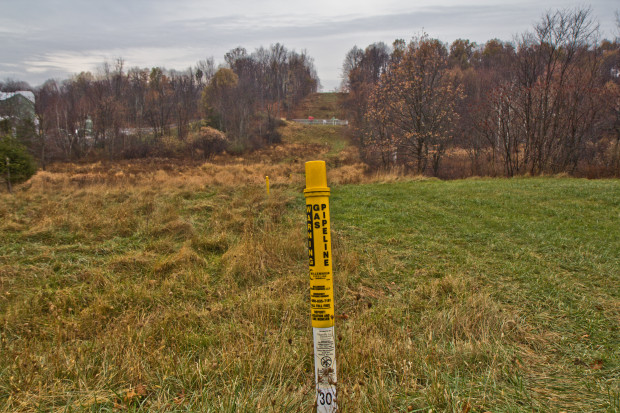
Kimberly Paynter / WHYY
The Millennium pipeline in New York State. Millennium wants to connect to the CPV power plant by building a 7.8 mile pipeline called the Valley Lateral. That project was rejected by New York over downstream climate impacts.
Unusual vetting process
What little attention the Valley Energy Center is attracting today dwarfs the virtual silence that greeted its unveiling. In 2008, CPV, a developer primarily of gas-fired electricity in the Northeast, came to Wawayanda, pitching a state-of-the-art facility that would generate enough “clean, low emissions electricity” to power more than 600,000 New York homes. The town was conveniently located near a transmission line.
In New York, state regulators typically review power plants proposed by private developers. At the time, though, the committee that would have evaluated such infrastructure wasn’t in place because the law authorizing it had expired. CPV sought an environmental assessment of its proposal from the Town of Wawayanda Planning Board, a rare request for a part-time body that mostly considers subdivisions, strip malls and car washes, people involved in the process say. Some believed a board composed of residents didn’t have the expertise to examine a utility-scale project, but most of the board’s members – enticed by CPV’s promises of economic rewards — were eager to move ahead.
CPV offered the town tax and benefit payments for hosting its facility totaling $11 million over 20 years. Millions more would go toward local schools and fire districts, the company promised. All told, CPV said, the plant would infuse more than $52 million into the county over this period.
In 2009, the planning board’s review stalled after consultants hired by the town flagged potential problems with the site, such as designated wetlands and endangered-species habitat. CPV got around the roadblock by agreeing to do additional studies after the board had approved a draft of the plant’s environmental assessment. The town then fired the consultants who had raised concerns, replacing them with a team that would find no major environmental impacts.
“The town wanted the project,” said Karen McDonald, one of the consultants who lost her job. “They never did an assessment of the true costs.”
Planning board chair Barbara Parsons declined to comment on the process, as did the town’s attorney, David Bavoso. In regulatory filings, the town has said the CPV plant “completed a comprehensive review costing hundreds of thousands of dollars,” which resulted in design modifications that will limit environmental harm.
By the time most residents learned about the plant, it had already been approved. Community opposition didn’t gain momentum until 2014, when fracking became a contentious issue in New York and the moratorium was imposed. Feeling duped by what they considered a disingenuous fracking ban, the plant’s critics traveled to rallies in Albany and petitioned Cuomo.
In 2015, some residents sued the town of Wawayanda, claiming its planning board had carelessly assessed the plant’s environmental impacts — a claim the town has disputed in court hearings.
“People want to operate this facility, with all its environmental and climate implications, without studying it,” said plaintiff’s lawyer Michael Sussman.
At a state appellate court hearing in October, Sussman argued that New York had “radically changed its energy policy” since the plant was approved — grounds for a new environmental assessment. A lawyer for CPV responded that Cuomo’s fracking moratorium had no bearing on gas plants, like the one taking shape in Wawayanda, which would draw their fuel from other states. A decision is expected any day.
‘Red flags’
To its opponents, the CPV gas plant is the illegitimate progeny of pay-to-play dealings implicating a company executive and Cuomo’s “right-hand man,” in the words of federal prosecutors. In 2016, they secured indictments against Peter Galbraith Kelly, CPV’s former head of external affairs, and Joseph Percoco, Cuomo’s former executive deputy secretary, on six counts of bribery, extortion and fraud. The complaint charges that Kelly arranged for CPV to pay $287,000 in bribes to Percoco from 2012 to 2016 “in exchange for Percoco’s official assistance to benefit the company.”
According to the complaint, Kelly lobbied Percoco in an attempt to influence regulatory approvals and financing for the Wawayanda plant. Over the years, it’s alleged, the executive relied on legal perks to woo the aide — a $279 steakhouse lunch, a $2,748 fishing trip — before turning to bribes. Kelly is accused of creating what prosecutors call a “low-show” job for Percoco’s wife, who was paid $7,500 a month for doing little work.
In return, Percoco is accused of trying to help CPV land a lucrative agreement with the Cuomo administration, under which the state would buy power produced by the plant for 15 years. CPV valued such a contract at $100 million, according to the complaint.
Whether the alleged corruption enabled the plant’s approval is impossible to say. The federal complaint doesn’t answer that question, and prosecutors declined to discuss the criminal case, slated for trial in January.
CPV and Cuomo have said little since the indictments were announced last year. At the time, the governor called the charges against Percoco, a family friend, “a profoundly sad situation,” and said “those found guilty of abusing the public’s trust should and will be punished.” Governor’s Counsel Alphonso David ordered state agencies to suspend communications with CPV, including any final state regulatory approvals for its Wawayanda plant.
In a written statement, CPV described Kelly’s alleged conduct as “inconsistent with who we are,” and vowed to “continue our work in accordance with the high level of excellence our communities and partners have come to expect of us.” The indictment doesn’t link CPV itself to the alleged corruption. According to the government’s complaint, an unnamed former president for the firm told prosecutors its former CEO had “expressed concern about hiring the wife of a senior member of the Governor’s staff while the energy company was seeking extensive regulatory review of its power plant,” and had directed Kelly to get an ethics opinion from Cuomo’s office. That opinion never came, prosecutors allege.
The scandal has made plant critics deeply suspicious. Many can’t help but notice that the alleged bribery occurred while CPV was seeking critical state approvals such as air-pollution permits. Could that explain how state agencies let a project of this magnitude be handled by a town board? Or why state environmental regulators have seemed willing to excuse potential wetlands and endangered-species problems?
“There are big red flags that have no explanation other than corruption and big-money influence,” said Pramilla Malick, of Protect Orange County, whose house sits a quarter-mile from the compressor station. She and others have urged state officials to re-examine the gas plant and have voiced objections during the permitting of the Valley Lateral Project, a 16-inch pipeline planned to deliver 130 million cubic feet of gas a day to it. The pipeline, proposed in 2015 by Millennium Pipeline Company, sparked a protracted review by the New York State Department of Environmental Conservation over its possible impacts on wetlands and streams, culminating last summer in a six-hour public hearing and 6,000 written comments.
By September, state environmental regulators had denied the pipeline a permit on a conditional basis, pointing to what they called an “inadequate and deficient” climate analysis conducted by the Federal Energy Regulatory Commission, the regulator that approves new interstate gas pipelines.
FERC, which has long refused to take a comprehensive look at the climate effects of gas pipelines, said it simply relied on the town of Wawayanda’s environmental review – a position Cornell’s Ingraffea described as “absurd.”
Ingraffea, having pored over that review and the permit applications, said the company’s emissions calculations understate the plant’s climate footprint. CPV’s estimates have the facility pumping out 2.2 million tons of carbon dioxide annually, accounting for 7 percent of the New York power sector’s emissions, he said. This number doesn’t take into account the latest science on methane, a short-lived but exceptionally potent greenhouse gas released during drilling and transport of natural gas. Factoring in methane leaks, Ingraffea calculated that the plant would spew at least 3.3 million tons of greenhouse gases per year.
FERC has since overturned the state Department of Environmental Conservation’s permit denial for Millennium’s Valley Lateral pipeline. The department, whose appeal of FERC’s decision could be heard in federal court as early as January, said in a statement that it is “committed to ensuring the protection of New York’s natural resources, and will continue to vigorously defend its right to do so.” A spokeswoman for Millennium blamed the dispute on opposition to the CPV plant. The pipeline, she said, is “really the only thing standing between that plant running and not.” On Dec. 7, meanwhile, a federal court lifted the existing stay on the pipeline, allowing Millennium to begin construction.
Many plant opponents are preparing for defeat. Naomi Miller, a social worker from neighboring Middletown, fought CPV passionately for three years. In 2015, she and five others, including the actor James Cromwell, sat on crates outside the plant site and chained themselves together with bike locks, halting construction. The so-called Wawayanda Six were arrested for disorderly conduct. Last June, a county judge fined them each $375.
Construction has continued nonetheless. Miller – put off by what she called “the ambiguity of not allowing fracking in your state but allowing a plant burning fracked gas” — has moved to Vermont.
The Center for Public Integrity is a nonprofit, nonpartisan investigative news organization in Washington, D.C. Susan Phillips of StateImpact Pennsylvania contributed to this story.
This story has been updated to add that a stay on the Valley Lateral pipeline was lifted by a federal court on Dec. 7, 2017.
StateImpact Pennsylvania is a collaboration among WITF, WHYY, and the Allegheny Front. Reporters Reid Frazier, Rachel McDevitt and Susan Phillips cover the commonwealth’s energy economy. Read their reports on this site, and hear them on public radio stations across Pennsylvania.
(listed by story count)
StateImpact Pennsylvania is a collaboration among WITF, WHYY, and the Allegheny Front. Reporters Reid Frazier, Rachel McDevitt and Susan Phillips cover the commonwealth’s energy economy. Read their reports on this site, and hear them on public radio stations across Pennsylvania.
Climate Solutions, a collaboration of news organizations, educational institutions and a theater company, uses engagement, education and storytelling to help central Pennsylvanians toward climate change literacy, resilience and adaptation. Our work will amplify how people are finding solutions to the challenges presented by a warming world.